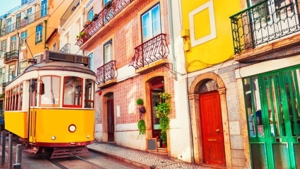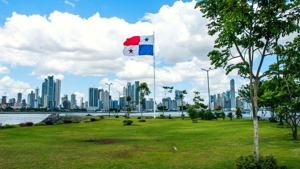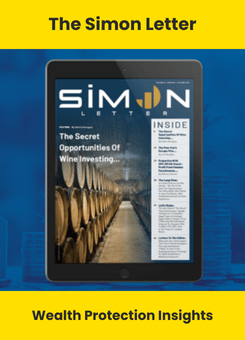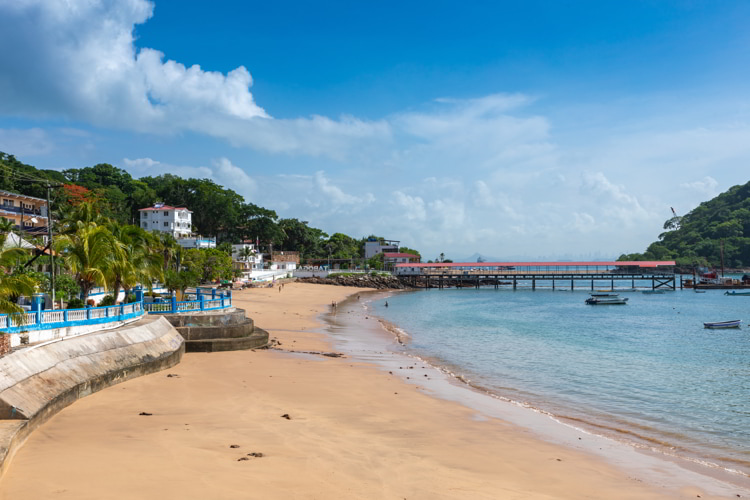If you stand on the Panama Canal side of the Causeway and look straight out into the bay, you’ll see a large landmass rising out of the water. That’s Isla Taboga.
Thirty minutes away by ferry, Taboga is home to the closest desirable beaches to Panama City.
This is the most convenient beach escape for residents of Panama City. You needn’t worry about traffic or delays on the weekends or holidays.
The beaches on Taboga are beautiful—some are sandy, others rocky… they’re pristine… and the water is a sparkling blue-green.
While the island doubles in population on the weekends and holidays, there are quieter, more private corners of Taboga where you’ll find empty beaches.
San Pedro has just under 2,000 residents and is the only town on the island. The locals take great care of their home—flowers line the streets, there are plazas and benches for relaxing and enjoying views of the Pacific, sculptures and religious statues shrouded in roses are around every corner, and the streets are kept clean. There isn’t a single piece of garbage in sight. I’m told the sidewalks are swept every day.
On my recent trip, I was impressed by how tidy and picturesque the town is. The streets are easily accessible on foot or bike. No one owns a car here. They walk, bike, or—the preferred mode of transportation for those who can afford it—they get around in a golf cart or mule. You’ll see these little vehicles all over the island.
A laid-back, island vibe can be felt everywhere you go. Life moves more slowly here, and there’s no rush. Restaurants, bars, and kiosks line the streets and the beaches, selling seafood caught by local fishermen that very morning.
The homes in town are beautiful, each a different color, each unique, many with manicured bushes and flowers growing in front. Mediterranean-style villas are a common theme, and there are a few wooden homes left behind from the days of U.S. occupation.
If you make Taboga your home, your recreation options will revolve around the sea. You can swim, kayak, stand-up paddle, fish, jet ski, dive, boat, and enjoy any other aquatic activity. On land you can hike a couple different trails or go birdwatching.
Isla Taboga is nicknamed the Island of Flowers. It’s also an island of rich history… including pirates. In town there’s a 16th century church (the second-oldest operational church in the Western Hemisphere), Francisco Pizzaro’s home, the house where French artist Paul Gauguin lived for a time, and if you hike to the highest point on the island (Cerro Vigía) you’ll find a World War II bunker left behind by the U.S. military.
Finding Taboga Island, Panama
Taboga is a 12-square-kilometer island situated in the Gulf of Panama in the Pacific Ocean, 20 kilometers off the mainland.
Getting here is simple. Two ferry companies provide service seven days a week to and from the island. Taboga Express charges US$20 round-trip and Barcos Calypso charges US$14 round-trip. Both leave from Causeway Amador and take 30 to 45 minutes to reach Taboga.
You’ll need to buy your tickets on the companies’ websites ahead of time as the ferries fill up quickly.
The boat ride to Isla Taboga is beautiful. You’ll pass by dozens of gigantic cargo ships waiting their turn to pass through the Canal.
You’ll get dropped off on Taboga’s main pier in town near Playa Honda.
Thrive On Just Your Social Security Income (If You Own A Home)
As is true for all islands, many expenses on Isla Taboga are higher than on the mainland. That said, there are savings because the lifestyle is more natural: You won’t be tempted to splurge on entertainment simply because it doesn’t exist.
Utilities like gas, electricity, and water are cheaper here than in Panama City, as is rent.
Rent for a two-bedroom home in town will set you back about US$500 to US$1,000 a month. Budget at least US$800 a month for a high-quality, comfortable rental.
A meal for two at a mid-range restaurant costs about US$50, or US$15 to US$20 a plate.
A couple renting their home should budget about US$2,500 a month for a well-appointed lifestyle on Taboga. Homeowners will spend around US$1,600 a month.
Click here for a more detailed breakdown of living expenses on Isla Taboga.
The Expat Experience
There are around 300 expats from the United States, Canada, Europe, and Latin America living on Isla Taboga. They come from all ages, backgrounds, and careers.
Many are entrepreneurs and have started their own businesses here. Others are digital nomads, taking advantage of the island’s excellent internet and electricity to do their remote work.
A large group of these expats are retirees.
The expat community is close-knit and well-connected. You’ll quickly find opportunities for volunteering and for socializing, including the cultural committee, Lions Club, environmental projects, drinks at the beach or Calaloo restaurant, poker nights, ladies’ walks, activities on the water and at the beach, and more.
You will need to learn Spanish if you make Taboga your home.
Very few locals speak basic English. Your new life will be significantly easier if you pick up conversational Spanish, especially if you plan to start a business, build a home, or get involved in any way with the local community.
The good news is that most locals are happy to help and many would gladly give you classes.
Health Care— “Cheap And Wonderful”
There’s only one health care facility on Isla Taboga, a public Centro de Salud run by the Ministry of Health (MINSA). Cynthia Cudmore Mulder, co-owner of Calaloo restaurant and Cerrito Tropical Eco-Lodge, tells me that the doctor is wonderful.
Cynthia explains that the clinic is open until 3 p.m. each day and after that, if you have an emergency, they’ll do their best to get you on a boat to the city. She says that the clinic is subsidized, making it extremely affordable. You’ll only pay US$1 for a consult and US$10 for a basic procedure.
She recalls one guest at her eco-lodge who had a cough and went to the clinic where he was given a free COVID test. After the test came back negative, the doctor prescribed him three different kinds of medicine. The guest paid US$10 total… an enormous bargain for quality care.
Ocean Lovers Will Never Be Bored
Here are a few activities you can enjoy year-round on Taboga…
- Fishing
- Whale-watching tours
- Diving and snorkeling classes
- Kayak or stand-up paddle
- Hike to the top of Cerro Vigía or Cerro La Cruz for stunning, 360-degree views of the island, the bay, and the Panama City skyline
- Go birdwatching or observe nesting sea turtles from August through October
- Head to the beach—Playa Restinga and Playa Honda are the most popular
- Indulge in delicious, fresh caught seafood. The main street is lined with restaurants and kiosks selling expertly prepared seafood recipes, but the expat favorite is Calaloo, close to the pier
The Property Market In Taboga Island, Panama
Most of the homes you’ll find for sale or rent on Taboga are in San Pedro town, along the main road. Many properties have been abandoned over the years as residents move to the mainland, and you can find houses in need of renovation for cheap.
If you’re in the market for a home that’s ready to move into, you can buy a two-bedroom home in town for about US$200,000 to US$250,000. It’s possible to find a nice home for less, but you’d need to visit Taboga to scout properties here yourself. Online listings for Taboga properties are few and far between, and many people sell by word of mouth (and that’s how you’ll get the best deals).
Entrepreneurs Wanted
“Would you recommend Taboga for expats looking to start a business?” I asked Cynthia, following her around the grounds of her Cerrito Tropical Eco-Lodge.
“I’d say Taboga is a good place for entrepreneurs if their main goal is a lifestyle change. If their motive is purely profit, they should look elsewhere,” she tells me.
This is a small town; it doesn’t have the population to support a large business.
Cynthia says that an affordable coffee and pastry shop would be welcome on the island, as would a watersport rental company.
Any tourism business would likely be profitable here. This includes lodging—there are only a few hotels on the island and they’re usually booked. You could open a hotel or Airbnb.
You could tap into the undeveloped eco-tourism market by organizing birdwatching, snorkeling, diving, wildlife, or sailing tours—anything that gets visitors close to Taboga’s amazing biodiversity.
If you’re skilled at any water sport—snorkeling, kayaking, stand-up paddle, etc.—you could give lessons, and if you have a boat you could offer activities like sportfishing, wakeboarding, tubing, waterskiing, and more.
Infrastructure And Services Are Developing
Taboga, Panama, is self-sufficient in terms of electricity, and has its own generator. It’s very reliable, and the power only goes out two or three times a year during rainy season storms (it’s usually back up and running within a few minutes).
There’s dependable, high-speed internet on the island, and there’s talk of fiber-optic internet coming to Taboga soon.
The island has its own desalination plant that produces about 250,000 gallons of potable water daily.
The desalination plant frequently malfunctions and there are droughts on the island. You’ll want to have a backup water system.
San Pedro town is a humble village and you won’t find many services here. There’s a Banco Nacional ATM (but no branch), a police station, a firefighters’ station, and three mini supermarkets.
The mini supermarket La Solución will do your shopping for you in Panama City for a fee—good news if you don’t want to take regular trips to the city.
Is Isla Taboga, Panama, For You?
If you’re after an ocean lifestyle in a destination that has the feel of a small village and that’s close to Panama City, you owe it to yourself to join the growing community of expats who have found their dream life on Isla Taboga.













